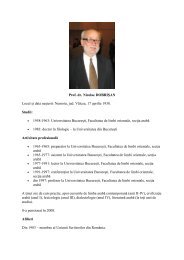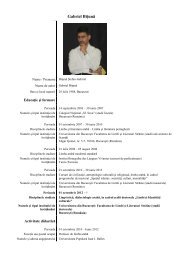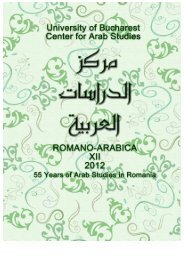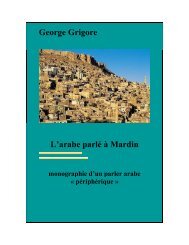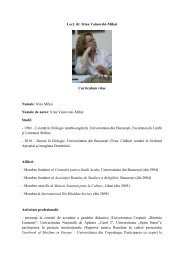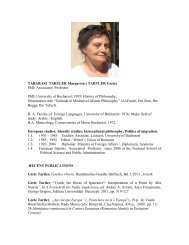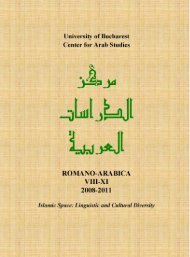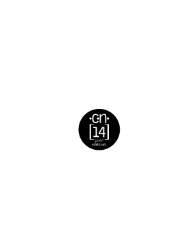University of Bucharest
University of Bucharest
University of Bucharest
You also want an ePaper? Increase the reach of your titles
YUMPU automatically turns print PDFs into web optimized ePapers that Google loves.
The present article is intended to give an inkling <strong>of</strong> this continued work on<br />
the H~ūzistāni dialects. For the sake <strong>of</strong> brevity, only some examples from these<br />
poems will be shown and a set <strong>of</strong> peculiarities will be discussed that can be<br />
discerned from them. The chapters <strong>of</strong> the above-mentioned book are divided<br />
according to the townships <strong>of</strong> H~ūzistān, and under each township (šahristān in<br />
Persian) the poets living there are discussed in detail. Any <strong>of</strong> the townships could<br />
have been chosen for the above-mentioned purpose, but what struck the eye in<br />
connection with the township <strong>of</strong> Dašt-i Āzādagān is that many <strong>of</strong> its poets had<br />
composed panegyrical poems in which they praised any <strong>of</strong> the twelve Šī‗ī Imams.<br />
This topic is not to be found so frequently in any other region <strong>of</strong> the province. The<br />
reason for this phenomenon remains yet unclear, although it is correct to ascertain<br />
that many ‗Alids, the descendants <strong>of</strong> Imam ‗Alī, have been living for centuries in<br />
this area. 3<br />
2. The locality and its population<br />
Dašt-i Āzādagān means in Persian the ‗field <strong>of</strong> the free-born‘. It is situated<br />
to the west <strong>of</strong> the provincial capital Ahwāz and has a common border with Iraq.<br />
To the north lies the township <strong>of</strong> Dizfūl and Šūš, to the south H~urramšahr with the<br />
Iranian Gulf region. In Iran, in general, the changing <strong>of</strong> town names and township<br />
names are never easy to follow, the changing <strong>of</strong> names in the Arabic-speaking<br />
areas has particularly been complex throughout the history <strong>of</strong> the country. A fact<br />
behind this may well be the constant efforts <strong>of</strong> consecutive regimes to Persianize<br />
the indigenous Arabic-speaking population.<br />
The region in question was first known in modern times by the name <strong>of</strong><br />
the most numerous Arab tribe inhabiting it, the Banī T}uruf. 4 Its name was<br />
subsequently changed to H}uwayza, while in 1935 it was again changed to Dašt-i<br />
Mīšān by the then ruling Rid}ā Šāh. This reflects the Middle Persian form Mēšān,<br />
the name <strong>of</strong> the whole <strong>of</strong> lower Mesopotamia and parts <strong>of</strong> H~ūzistān, that was used<br />
until the late Middle Ages. 5 Until 1944 when it became an independent<br />
administrative unit, it had formed a part <strong>of</strong> the township <strong>of</strong> Ahwāz. After the<br />
3<br />
Pūr-Kāz}im 1378/1999, 334.<br />
4<br />
See under Dašt-i Mīšān in Dihh~udā 1377/1998, 10905. See also the map showing the names <strong>of</strong><br />
tribes in Ingham 1982, 18.<br />
5<br />
Ingham 1997, 47 (Footnote 22). The area has been known under different forms <strong>of</strong> this name in<br />
various languages such as Greek, Syriac, Armenian and Hebrew. Even Yāqūt mentioned it under<br />
the name Dast-i Maysān. For a list <strong>of</strong> these forms, see Pūr-Kāz}im 1378/1999, 334., Streck-Morony<br />
1991, 918f and 920f. For Dast-i Mīsān, see also Dihh~udā 1377/1998, 10878.<br />
40



